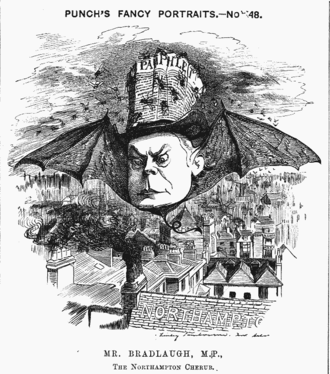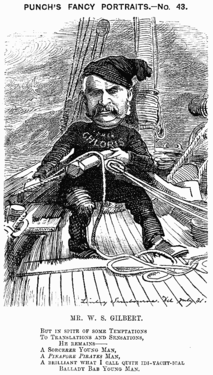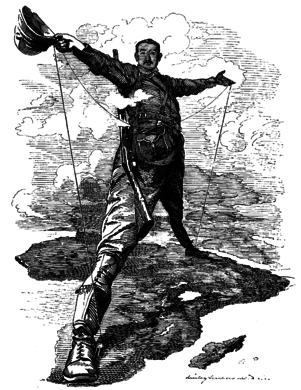Edward Linley Sambourne

Edward Linley Sambourne (4 January 1844 – 3 August 1910) was an English cartoonist and illustrator most famous for being a draughtsman for the satirical magazine Punch for more than forty years and rising to the position of ‘First Cartoonist’ in his final decade.
Early life and education
Edward Linley Sambourne was born in the family home at 15 Lloyd Square in Pentonville, London 4 January 1844, he was the only surviving child of Edward Mott Sambourne a furrier merchant in the City of London. His mother Frances Linley was the daughter of Peter Linley, who followed into the family business of scythe manufacture near Sheffield.
Linley was educated at various schools throughout England. Aged 10 or 11 he enrolled as a pupil in the City of London School but by 1857 he was at a school in Sheffield. From late 1857 to 1860 he had again enrolled in a new school, the Chester Training College where he was encouraged to pursue his talent for drawing. In 1860 aged 16, Linley enrolled in the South Kensington School of Art but only stayed a couple of months.
Punch

In 1861 Sambourne was apprenticed to John Penn & Son, marine engineers of Greenwich. Initially he worked under the founder’s son, John Penn Jr but was moved to the drawing office when his employer discovered his aptitude for draft drawing. In his spare time Sambourne continued to draw caricatures and study the great graphic artists such as William Hogarth and Albrecht Dürer. One version Sambourne recounts into the events leading to his introduction to the Punch's editor Mark Lemon is that his friend and fellow employee at Penn’s, Alfred German Reed, showed one of his sketches to his father the theatrical impresario Thomas German Reed. At his son’s urging Thomas passed the drawing on to Mark Lemon. Lemon was sufficiently impressed by the sketch that he encouraged Sambourne to take art lessons and consult the engraver Joseph Swain about drawing on wood. Pleased with the results Lemon published a drawing by Sambourne in the 27 April 1867 issue of Punch. This was an initial letter 'T' showing the politician John Bright striking a quintain.
Initially employed on a casual basis by Lemon, Sambourne was being asked to supply the decorated initial letters that stood at head of articles, stories and poems incorporating the first letter into a fanciful design. Between 1867 and 1874 Sambourne contributed 350 initial letters. Although Sambourne's distinctive style emerged only slowly, he became a regular staff member of Punch in 1871, and, at the end of John Tenniel's long occupancy in 1901, its chief principal cartoonist.
Unusually for a black and white artist, Sambourne used a huge library of photographic images to give accuracy to his work, which was characterized by a vivid and decisive linearity as well as an artistic inventiveness that took his images far beyond the simple concept of a cartoon or 'comic cut'. The quality of his work for Punch was acknowledged by the Royal Academy, which exhibited his drawings over a 20-year period.
Other works
While his work for Punch occupied most of his energy it was not Sambourne's only source of income he would often accept commissions for individuals, books, magazines and advertisements. These include:
Book illustrations
- Military Men I have met ..., Edward Dyne Fenton, 1872
- Our Autumn Holiday on French Rivers ..., James Lynam Molly, 1874
- Our Holiday in the Scottish Highlands, Arthur à Beckett, 1876
- The Royal Umbrella. [A tale.] ..., Alfred Frederick Pollock Harcourt, 1879
- The Modern Arabian Nights, Arthur a' Beckett, 1877
- Poems of Edgar Allan Poe, 1881
- The Water Babies, Charles Kingsley, 1885
- Sherryana, F. W. Cosens, 1886
- Friends and Foes from Fairy Land, Edward Knatchbull-Hugessen, 1886
- The Green Above The Red: More Blarney Ballads, Charles L. Graves, 1889
- The Real Adventures of Robinson Crusoe, F. C. Burnand, 1893
Diploma
- International Fisheries Exhibition Diploma, 1883–84
Invitations
- Invitation to the Lord Mayor's Banquet, 1888
Advertisements
- Apenta aperient water
- Philip Morris cigarettes, 1889
- Rose's lime juice
- Mazawatte tea
- Lanchashire Railway
Covers
- The Naval and Military Gazette
- The Pall Mall Gazette
- The Sketch
- The Sphere
Illustrations
- Black and White, 1891
- The British Workman
- The Illustrated London News
- The Piccadilly Magazine
- The Pictorial World
Examples of his work
Examples from his series of caricatures in Punch 1881–2, "Punch's Fancy Portraits":



 Cecil Rhodes bestriding Africa.
Cecil Rhodes bestriding Africa.
More of Sambourne's caricatures from this series can be seen in the articles for William Harrison Ainsworth, Emma Albani, Matthew Arnold, Lord Charles Beresford, William Black, George Granville Bradley, Robert Browning, Hugh Childers, Lord Randolph Churchill, Henry Drummond Wolff, Henry Fawcett, James Anthony Froude, George Joachim Goschen, Charles Gounod, John Holker, Henry Labouchère, Henry Parry Liddon, John Lubbock, 1st Baron Avebury, Henry Edward Manning, Oscar Wilde, Ouida, James Payn, George Augustus Henry Sala, Eyre Massey Shaw, Arthur Sullivan, William James Erasmus Wilson, and Garnet Wolseley, 1st Viscount Wolseley
See also: Phylloxera, Cecil Rhodes.
Descendants
Sambourne's descendants include his grandson Oliver Messel (an acclaimed set designer and architect), his granddaughter Anne, 6th Countess of Rosse, his great-grandson the Earl of Snowdon (the photographer and documentary filmmaker), and great-great-grandson Viscount Linley (the furniture designer and chairman of Christie's auction house). Due to the large number of photographs taken of himself posing as a model for drawings, Boston-based journalist Susan Zalkind has suggested that her great-great-great-grandfather, Sambourne, is the "grandfather of the selfie."[1]
See also
Further reading
- McMaster, Juliet (2009). That Mighty Art of Black-And-White: Linley Sambourne, Punch, and the Royal Academy. Edmonton, Alberta, Canada: Ad Hoc Press.
- Nicholson, Shirley (2010). A Victorian household : based on the diaries of Marion Sambourne (New rev. ed.). London: Barwis Press. ISBN 978-0-902242-78-4.
- Nicholson, Shirley (1999). An Edwardian Bachelor: Roy Sambourne. London: The Victorian Society. ISBN 0-901657-30-1.
- Nicholson, Shirley (1992). Nymans : the story of a Sussex garden. Stroud: Alan Sutton in association with the National Trust. ISBN 978-0750902045.
- Ormond, Leonee (2010). Linley Sambourne : illustrator and Punch cartoonist (1. publ. ed.). London: Paul Holberton Pub. ISBN 978-1-907372-03-2.
External links
| Wikimedia Commons has media related to Edward Linley Sambourne. |
| Wikisource has the text of a 1911 Encyclopædia Britannica article about Edward Linley Sambourne. |
- Portrait of Linley Sambourne by Harry Furniss
- Linley Sambourne House
- Sambourne's Illustrations from Punch in HeidICON
- Sambourne's personal diary for 1906
References
- ↑ Zalkind, Susan (2015). "Grandfather of the Selfie". The Baffler. Cambridge, Massachusetts (29).